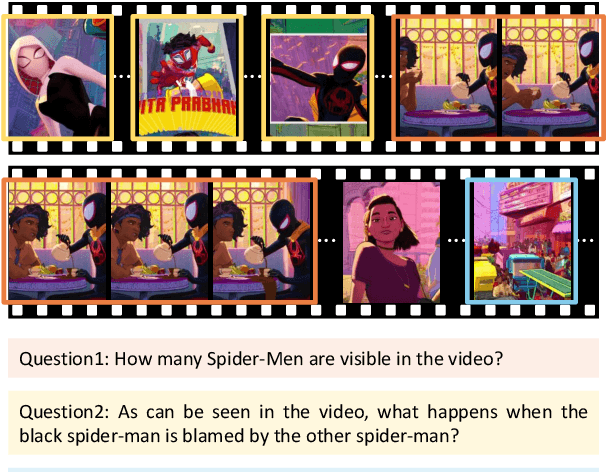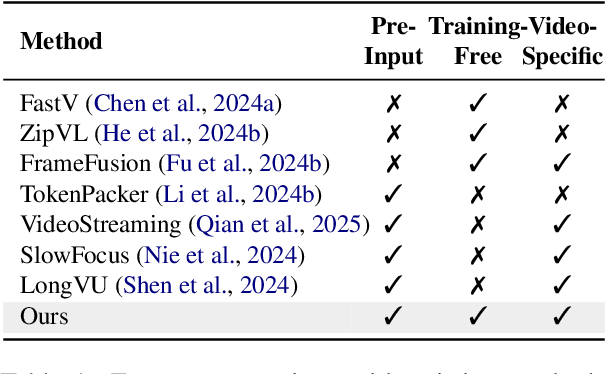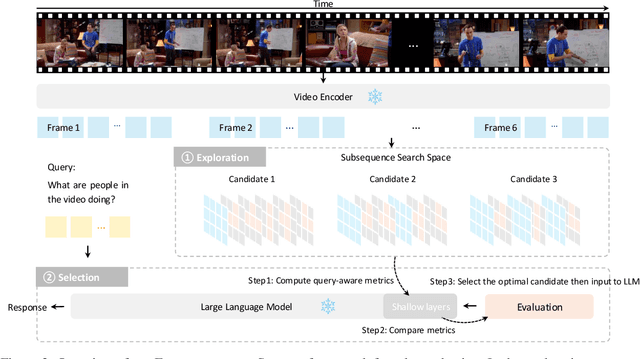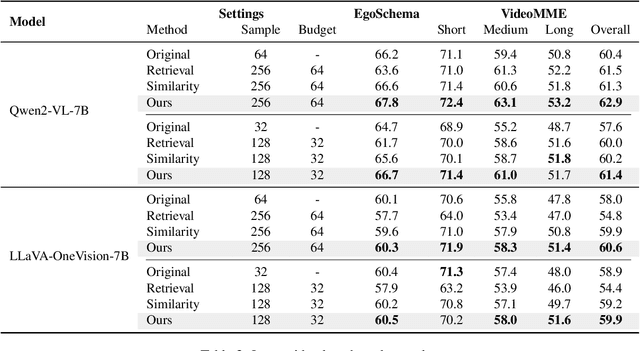Wenya Wang
STARE at the Structure: Steering ICL Exemplar Selection with Structural Alignment
Aug 28, 2025Abstract:In-Context Learning (ICL) has become a powerful paradigm that enables LLMs to perform a wide range of tasks without task-specific fine-tuning. However, the effectiveness of ICL heavily depends on the quality of exemplar selection. In particular, for structured prediction tasks such as semantic parsing, existing ICL selection strategies often overlook structural alignment, leading to suboptimal performance and poor generalization. To address this issue, we propose a novel two-stage exemplar selection strategy that achieves a strong balance between efficiency, generalizability, and performance. First, we fine-tune a BERT-based retriever using structure-aware supervision, guiding it to select exemplars that are both semantically relevant and structurally aligned. Then, we enhance the retriever with a plug-in module, which amplifies syntactically meaningful information in the hidden representations. This plug-in is model-agnostic, requires minimal overhead, and can be seamlessly integrated into existing pipelines. Experiments on four benchmarks spanning three semantic parsing tasks demonstrate that our method consistently outperforms existing baselines with multiple recent LLMs as inference-time models.
LLMC+: Benchmarking Vision-Language Model Compression with a Plug-and-play Toolkit
Aug 13, 2025Abstract:Large Vision-Language Models (VLMs) exhibit impressive multi-modal capabilities but suffer from prohibitive computational and memory demands, due to their long visual token sequences and massive parameter sizes. To address these issues, recent works have proposed training-free compression methods. However, existing efforts often suffer from three major limitations: (1) Current approaches do not decompose techniques into comparable modules, hindering fair evaluation across spatial and temporal redundancy. (2) Evaluation confined to simple single-turn tasks, failing to reflect performance in realistic scenarios. (3) Isolated use of individual compression techniques, without exploring their joint potential. To overcome these gaps, we introduce LLMC+, a comprehensive VLM compression benchmark with a versatile, plug-and-play toolkit. LLMC+ supports over 20 algorithms across five representative VLM families and enables systematic study of token-level and model-level compression. Our benchmark reveals that: (1) Spatial and temporal redundancies demand distinct technical strategies. (2) Token reduction methods degrade significantly in multi-turn dialogue and detail-sensitive tasks. (3) Combining token and model compression achieves extreme compression with minimal performance loss. We believe LLMC+ will facilitate fair evaluation and inspire future research in efficient VLM. Our code is available at https://github.com/ModelTC/LightCompress.
Coordinating Search-Informed Reasoning and Reasoning-Guided Search in Claim Verification
Jun 09, 2025Abstract:Multi-hop claim verification is inherently challenging, requiring multi-step reasoning to construct verification chains while iteratively searching for information to uncover hidden bridging facts. This process is fundamentally interleaved, as effective reasoning relies on dynamically retrieved evidence, while effective search demands reasoning to refine queries based on partial information. To achieve this, we propose Hierarchical Agent Reasoning and Information Search (HARIS), explicitly modeling the coordinated process of reasoning-driven searching and search-informed reasoning. HARIS consists of a high-level reasoning agent that focuses on constructing the main verification chain, generating factual questions when more information is needed, and a low-level search agent that iteratively retrieves more information, refining its search based on intermediate findings. This design allows each agent to specialize in its respective task, enhancing verification accuracy and interpretability. HARIS is trained using reinforcement learning with outcome-based rewards. Experimental results on the EX-FEVER and HOVER benchmarks demonstrate that HARIS achieves strong performance, greatly advancing multi-hop claim verification.
Adaptive Detoxification: Safeguarding General Capabilities of LLMs through Toxicity-Aware Knowledge Editing
May 28, 2025Abstract:Large language models (LLMs) exhibit impressive language capabilities but remain vulnerable to malicious prompts and jailbreaking attacks. Existing knowledge editing methods for LLM detoxification face two major challenges. First, they often rely on entity-specific localization, making them ineffective against adversarial inputs without explicit entities. Second, these methods suffer from over-editing, where detoxified models reject legitimate queries, compromising overall performance. In this paper, we propose ToxEdit, a toxicity-aware knowledge editing approach that dynamically detects toxic activation patterns during forward propagation. It then routes computations through adaptive inter-layer pathways to mitigate toxicity effectively. This design ensures precise toxicity mitigation while preserving LLMs' general capabilities. To more accurately assess over-editing, we also enhance the SafeEdit benchmark by incorporating instruction-following evaluation tasks. Experimental results on multiple LLMs demonstrate that our ToxEdit outperforms previous state-of-the-art methods in both detoxification performance and safeguarding general capabilities of LLMs.
Knowledge Grafting of Large Language Models
May 24, 2025Abstract:Cross-capability transfer is a key challenge in large language model (LLM) research, with applications in multi-task integration, model compression, and continual learning. Recent works like FuseLLM and FuseChat have demonstrated the potential of transferring multiple model capabilities to lightweight models, enhancing adaptability and efficiency, which motivates our investigation into more efficient cross-capability transfer methods. However, existing approaches primarily focus on small, homogeneous models, limiting their applicability. For large, heterogeneous models, knowledge distillation with full-parameter fine-tuning often overlooks the student model's intrinsic capacity and risks catastrophic forgetting, while PEFT methods struggle to effectively absorb knowledge from source LLMs. To address these issues, we introduce GraftLLM, a novel method that stores source model capabilities in a target model with SkillPack format. This approach preserves general capabilities, reduces parameter conflicts, and supports forget-free continual learning and model fusion. We employ a module-aware adaptive compression strategy to compress parameter updates, ensuring efficient storage while maintaining task-specific knowledge. The resulting SkillPack serves as a compact and transferable knowledge carrier, ideal for heterogeneous model fusion and continual learning. Experiments across various scenarios demonstrate that GraftLLM outperforms existing techniques in knowledge transfer, knowledge fusion, and forget-free learning, providing a scalable and efficient solution for cross-capability transfer. The code is publicly available at: https://github.com/duguodong7/GraftLLM.
MTSA: Multi-turn Safety Alignment for LLMs through Multi-round Red-teaming
May 22, 2025Abstract:The proliferation of jailbreak attacks against large language models (LLMs) highlights the need for robust security measures. However, in multi-round dialogues, malicious intentions may be hidden in interactions, leading LLMs to be more prone to produce harmful responses. In this paper, we propose the \textbf{M}ulti-\textbf{T}urn \textbf{S}afety \textbf{A}lignment (\ourapproach) framework, to address the challenge of securing LLMs in multi-round interactions. It consists of two stages: In the thought-guided attack learning stage, the red-team model learns about thought-guided multi-round jailbreak attacks to generate adversarial prompts. In the adversarial iterative optimization stage, the red-team model and the target model continuously improve their respective capabilities in interaction. Furthermore, we introduce a multi-turn reinforcement learning algorithm based on future rewards to enhance the robustness of safety alignment. Experimental results show that the red-team model exhibits state-of-the-art attack capabilities, while the target model significantly improves its performance on safety benchmarks.
Multi-Modality Expansion and Retention for LLMs through Parameter Merging and Decoupling
May 21, 2025Abstract:Fine-tuning Large Language Models (LLMs) with multimodal encoders on modality-specific data expands the modalities that LLMs can handle, leading to the formation of Multimodal LLMs (MLLMs). However, this paradigm heavily relies on resource-intensive and inflexible fine-tuning from scratch with new multimodal data. In this paper, we propose MMER (Multi-modality Expansion and Retention), a training-free approach that integrates existing MLLMs for effective multimodal expansion while retaining their original performance. Specifically, MMER reuses MLLMs' multimodal encoders while merging their LLM parameters. By comparing original and merged LLM parameters, MMER generates binary masks to approximately separate LLM parameters for each modality. These decoupled parameters can independently process modality-specific inputs, reducing parameter conflicts and preserving original MLLMs' fidelity. MMER can also mitigate catastrophic forgetting by applying a similar process to MLLMs fine-tuned on new tasks. Extensive experiments show significant improvements over baselines, proving that MMER effectively expands LLMs' multimodal capabilities while retaining 99% of the original performance, and also markedly mitigates catastrophic forgetting.
Rethinking Circuit Completeness in Language Models: AND, OR, and ADDER Gates
May 15, 2025Abstract:Circuit discovery has gradually become one of the prominent methods for mechanistic interpretability, and research on circuit completeness has also garnered increasing attention. Methods of circuit discovery that do not guarantee completeness not only result in circuits that are not fixed across different runs but also cause key mechanisms to be omitted. The nature of incompleteness arises from the presence of OR gates within the circuit, which are often only partially detected in standard circuit discovery methods. To this end, we systematically introduce three types of logic gates: AND, OR, and ADDER gates, and decompose the circuit into combinations of these logical gates. Through the concept of these gates, we derive the minimum requirements necessary to achieve faithfulness and completeness. Furthermore, we propose a framework that combines noising-based and denoising-based interventions, which can be easily integrated into existing circuit discovery methods without significantly increasing computational complexity. This framework is capable of fully identifying the logic gates and distinguishing them within the circuit. In addition to the extensive experimental validation of the framework's ability to restore the faithfulness, completeness, and sparsity of circuits, using this framework, we uncover fundamental properties of the three logic gates, such as their proportions and contributions to the output, and explore how they behave among the functionalities of language models.
Static or Dynamic: Towards Query-Adaptive Token Selection for Video Question Answering
Apr 30, 2025



Abstract:Video question answering benefits from the rich information available in videos, enabling a wide range of applications. However, the large volume of tokens generated from longer videos presents significant challenges to memory efficiency and model performance. To alleviate this issue, existing works propose to compress video inputs, but usually overlooking the varying importance of static and dynamic information across different queries, leading to inefficient token usage within limited budgets. To tackle this, we propose a novel token selection strategy, EXPLORE-THEN-SELECT, that adaptively adjust static and dynamic information needed based on question requirements. Our framework first explores different token allocations between static frames, which preserve spatial details, and dynamic frames, which capture temporal changes. Next, it employs a query-aware attention-based metric to select the optimal token combination without model updates. Our proposed framework is plug-and-play that can be seamlessly integrated within diverse video-language models. Extensive experiments show that our method achieves significant performance improvements (up to 5.8%) among various video question answering benchmarks.
Reinforcing Compositional Retrieval: Retrieving Step-by-Step for Composing Informative Contexts
Apr 15, 2025Abstract:Large Language Models (LLMs) have demonstrated remarkable capabilities across numerous tasks, yet they often rely on external context to handle complex tasks. While retrieval-augmented frameworks traditionally focus on selecting top-ranked documents in a single pass, many real-world scenarios demand compositional retrieval, where multiple sources must be combined in a coordinated manner. In this work, we propose a tri-encoder sequential retriever that models this process as a Markov Decision Process (MDP), decomposing the probability of retrieving a set of elements into a sequence of conditional probabilities and allowing each retrieval step to be conditioned on previously selected examples. We train the retriever in two stages: first, we efficiently construct supervised sequential data for initial policy training; we then refine the policy to align with the LLM's preferences using a reward grounded in the structural correspondence of generated programs. Experimental results show that our method consistently and significantly outperforms baselines, underscoring the importance of explicitly modeling inter-example dependencies. These findings highlight the potential of compositional retrieval for tasks requiring multiple pieces of evidence or examples.
 Add to Chrome
Add to Chrome Add to Firefox
Add to Firefox Add to Edge
Add to Edge